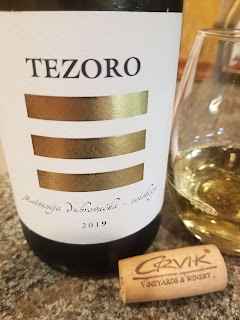Imagine being the founding member of the rock band
Faith No More and in 1992 opening for
Guns n' Roses in Budapest, yet the most memorable event at that concert was backstage being introduced to a local fruit brandy -- known as palinka in Hungary and rakija throughout the Balkins. That was the experience of bassist
Bill Gould who continued his education of rakija through subsequent Balkin tours as a musician and tourist for the subsequent 25+ years.
"During this time, I have been frustrated by the lack of awareness, as well as lack of availability, of what I believe to be one of the world's Great Spirits. And I wanted it for myself as well...I had people occasionally bring me bottles from the Old Country but sometimes they would break and when they did, a piece of my heart would break as well! Finally, in 2019 I realized that the only way to bring a premium version of this to the US was to do it myself. I had no experience with this industry but set out with a goal to bring a true, completely traditional handmade version -- the kind that is usually kept within the family and rarely offered for sale--to the US for the first time".

What Gould witnessed is how rakija is an intricate part of Eastern European life used to welcome visitors, toast celebratory occasions, or just a jolt of comfort. Home distillation is quite common and I can personally attest, is superior to some of the highest-quality fruit brandies on the market. Rakija is made from a number of fruits, from grapes, apricots, quince, pears, and with most popular, plums - referred to as slivowitz.

By launching
Yebiga, Gould is introducing the traditional processes of home distillation to a retail market. Currently, there are two plum brandies within the Yebiga brand:
BELA, a clear rakija and
PRVA, an oak-aged rakija. The spirits are distilled on a mountain farm near Kraljevo in Central Serbia. The plum orchard sits at 800m, the highest elevation point for plums, and subsists alongside pines and other conifers. BELA is produced from an equal share of
čačanska rodna and
čačanska lepotica plums -- both varieties created by the
Institute of Fruit Growing in Čačak, Serbia. This is the equivalent of
Cornell AgriTech regarding the development of new grape varieties. Both of these plums were released in 1975 and according to the Institute, are high-quality cultivars most suitable for desserts and slivowitz.

The plums are hand-harvested at full maturation which is quite labor-intensive since individual plums ripen at different intervals. This period lasts from late July to early August and after harvest, the pits are removed, and the fruit ferments from 10 days to 14 weeks. The fermented juice is then double distilled using a 500l wood-fired copper pot still. The wood for the fire is acquired from the local forest. Finally, the rakija is cut to 40% abv using pure mountain spring water.
Having no oak treatment the BELA provides a full expression of the fruit - from the cultivars to the evergreen terrain. Not sure if my sensory impressions were influenced by their story, but there's subtle pine mixed with the stone fruit aroma. Plums are clearly noticeable on the palate just before the soft burn and lengthy finish. I can see why the BELA was awarded double gold at the 2021 San Francisco World Spirits Competition.
The Yebiga rakija is currently available online via Mash&Grape ($31) and Yebiga and at retail locations in the following states: CA, IL, NY, NJ, DC, FL, TX, MO, & MI. There is a map of retail stores on the Yebiga website. Finally, they are available at Total Wine in California and Texas as well as at Binny's in Illinois.
Orchard and still photos courtesy of Yebiga.
Disclosure: We received samples from Yebiga through the BevFluence New Perspectives on Cider, Perry, and Brandy campaign in order to share our opinion about their products.

 Friday, February 3rd is the Feast Day of St. Blaise and this Armenian-born saint has been venerated in Dubrovnik as far back as 972. Tradition states that in that year St. Blaise warned a praying parish priest regarding a surprise Venetian attack, saving the city and becoming the walled city's primary patron saint. His statue overlooks the sea and his church resides next to the Bell Tower. Not bad for the bishop of Sebastea martyred in 316. In Dubrovnik, the celebration of the Festivity of St. Blaise is highlighted by a Procession led by the Bishop of Dubrovnik and priests carrying relics of the saint as well as a relic of the shroud of Jesus.
Friday, February 3rd is the Feast Day of St. Blaise and this Armenian-born saint has been venerated in Dubrovnik as far back as 972. Tradition states that in that year St. Blaise warned a praying parish priest regarding a surprise Venetian attack, saving the city and becoming the walled city's primary patron saint. His statue overlooks the sea and his church resides next to the Bell Tower. Not bad for the bishop of Sebastea martyred in 316. In Dubrovnik, the celebration of the Festivity of St. Blaise is highlighted by a Procession led by the Bishop of Dubrovnik and priests carrying relics of the saint as well as a relic of the shroud of Jesus. 






